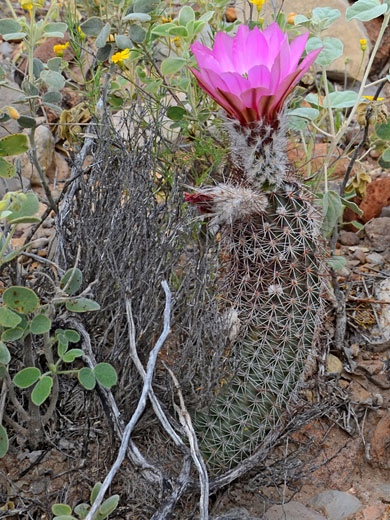Scientific name:
Echinocereus chisosensis
Common name:
Chisos Mountain hedgehog cactus
Range:
Restricted to the south side of the Chisos Mountains in Big Bend National Park
Form:
Short cylinders, up to 8 inches tall, single or loosely clumped
Habitat:
Chihuahuan Desert plains and scrub, usually sheltered beneath other vegetation; at elevations between 2,000 and 3,000 feet
Flowers:
Bright pink, darker at the base, appearing March to May

Distribution map for echinocereus chisosensis
Echinocereus chisosensis has one of the smallest ranges of any US cactus species, restricted to a strip of land maybe only 10 miles across, on the southeastern slopes of the Chisos Mountains in Big Bend National Park, west Texas; it inhabits gravelly places on ridges and along washes, usually partly hidden beneath grasses and bushes. It often grows amongst dog cholla plants.
Stems are relatively compact, at most four times as high as wide - up to 8 inches by 3 inches, and they have between 13 and 16 ribs, undulating along the crest. There are between 11 and 20 spines per areole, of which usually two (but ranging from one to six) are central, the rest radial. Spines are white, pale gray or pinkish, darker at the tips.
The large flowers, up to 3 inches wide, have bright pink tepals, whitish lower down then darker at the base, with dark midstripes on the undersurfaces. Anthers are yellow, stigma lobes green. Areoles on the pericarpel, below the flower, bear both spines and woolly hairs. Fruits are green pods, up to 1.5 inches long, spiny and woolly.
Stems are relatively compact, at most four times as high as wide - up to 8 inches by 3 inches, and they have between 13 and 16 ribs, undulating along the crest. There are between 11 and 20 spines per areole, of which usually two (but ranging from one to six) are central, the rest radial. Spines are white, pale gray or pinkish, darker at the tips.
The large flowers, up to 3 inches wide, have bright pink tepals, whitish lower down then darker at the base, with dark midstripes on the undersurfaces. Anthers are yellow, stigma lobes green. Areoles on the pericarpel, below the flower, bear both spines and woolly hairs. Fruits are green pods, up to 1.5 inches long, spiny and woolly.
All Contents © Copyright The American Southwest | Comments and Questions | Contribute | Affiliate Marketing Disclosure | Site Map


